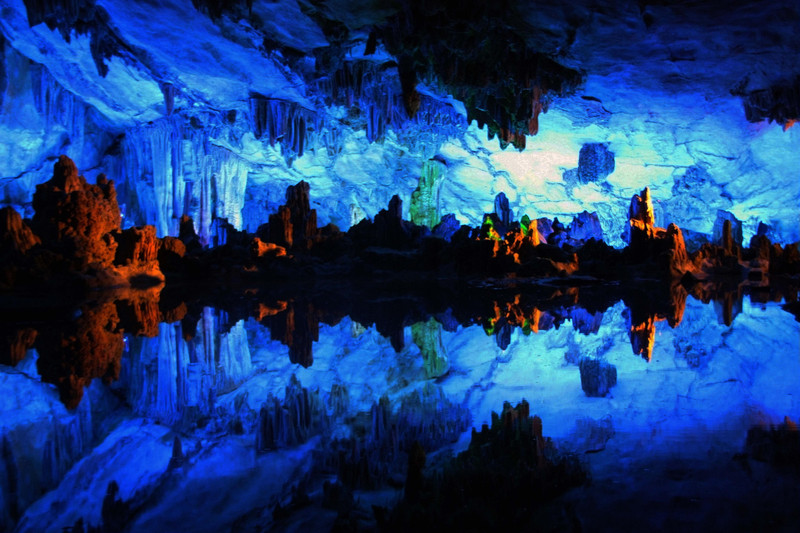Guilin is a story city that combines mountains, rivers and humanities.
After days of work, I finally waited for the May Day holiday, where I could relieve my fatigue and go out.
For this short holiday, after repeated screening, I chose Guilin, which has the best mountains and rivers in the world.
In primary school class, an article "Guilin Mountains and Waters" made me fascinated by Guilin. My work place is very close to Guilin and the transportation is very convenient, which enabled me to realize my trip to Guilin.
DAY 1 Reed Flute Rock, Elephant Trunk Mountain, East and West Alley, Xiaoyao Tower
On the first day, we arrived in Guilin at noon and chose the classic route in the city. I checked the geographical location online and found that Reed Flute Rock is far away from other scenic spots, and Elephant Trunk Mountain, Jingjiang Palace, Dongxi Lane, and Xiaoyao Tower are closer, so our route is Reed Flute Rock-Elephant Trunk Mountain-Dongxi Lane-Xiaoyao Tower
Reed flute cave
The Reed Flute Rock is called the "Guobin Cave" and its beauty is extraordinary. It is a huge cave formed by various stalactites and is also a unique product of the karst landform. There are a large number of beautiful stalagmites, stalactites, stone pillars, stone curtains, and stone flowers in the cave, forming the Shiling Morning Sunset, Hongluo Treasure Tabulate, Panlong Pagoda, Primeval Forest, Crystal Palace, Huaguoshan and other landscapes, like a fairyland. It is a veritable "Palace of Art of Nature".

elephant trunk Hill
Elephant Trunk Mountain can be said to be the city emblem and landmark of Guilin. It gets its name because its shape is like an elephant swimming in the water. It is also a famous moon-viewing resort, known as the "Xiangshan Water Moon".

Dongxi Lane, Xiaoyao Tower, Jingjiang Palace City Wall
After visiting Elephant Trunk Mountain, in the evening, we chose to have dinner at a barbecue restaurant in Dongxi Lane. After dinner, we walked out of the small shop and walked around the bustling Dongxi Alley. Dongxi Alley is the only historical street left over from the Ming and Qing Dynasties in Guilin. It was renovated in the past few years and became an antique commercial street, but it reflects Guilin. The historical context has witnessed the rise and fall of Guilin City in the nearly 1400 years since its establishment during the Wude period of the Tang Dynasty.
Xiaoyao Tower was built in the fourth year of Wude of the Tang Dynasty (621), named after Zhuangzi's "Xiaoyao Tour". Climbing the building, you can have a bird's eye view of the Lishui peaks. Xiaoyao Building has been damaged and built many times in the Tang, Song, Yuan, Ming, Qing and Qing Dynasties. Xiaoyao Tower was finally destroyed during the Anti-Japanese War. The Xiaoyao Building we see now was also rebuilt a few years ago.

We also walked around the outer wall of Jingjiang Palace to experience the prosperity and decline of the Ming Dynasty. There are also many residential areas at the foot of the royal city, where you can experience rare tranquility amidst the excitement.
DAY 2 Lijiang Yangshuo West Street
How could we say we had arrived in Guilin before the Li River? The next day, we visited the Li River section from Guilin-Yangshuo. It was indeed as stated in the textbook. The water of the Li River was so clear that you could see the sand and gravel at the bottom of the river; the water of the Li River was so green, as green as if it were a piece of flawless emerald. The mountains in Guilin are really strange. They rise from the ground one after another, each one is not connected, like old people, like giant elephants, and like camels. The mountains in Guilin are so beautiful, like green barriers, like newborn bamboo shoots, with bright colors that reflect the water; the mountains in Guilin are really dangerous, with dangerous peaks standing tall and strange rocks that seem to fall down if you are not careful.
After the cruise ship ended, we rushed to Yangshuo West Street non-stop to experience the simplicity of Yangshuo during the day and the style of night. West Street is very literary and artistic, with various folk songs and clear bars, and there are also many small shops. Although the street is not long, it is worth visiting. In the evening, we drank in a clear bar while listening to songs and chatting. We refused to leave for a long time.


DAY 3 Guihua Commune Scenic Area
On the third day, we needed to go home in the afternoon. We chose a new attraction-Guihua Commune Scenic Area as our last stop.
As a flower in Guilin City, sweet-scented osmanthus has its very profound culture. Guihua Commune is a scenic spot with the theme of Guihua culture. Although the scenic spot is not large, it has many highlights. The Osmanthus Culture Experience Hall tells the story of the past and present lives of osmanthus in Guilin. It also tells the connection between Guilin and sweet-scented osmanthus, the story of Guilin and sweet-scented osmanthus, and the "plank road" between sweet-scented osmanthus and the No. 1 champion. I immersively experienced a osmanthus IP video in the osmanthus culture experience hall. The colorful osmanthus rain made people can't help but exclaim "wow". The culture of the top scorer and osmanthus has greatly increased our knowledge.




It is also very suitable for picnics and camping. We set up a tent and some snacks to have a picnic on the grass in the scenic area to feel a moment of tranquility.

Previous Article:Yangshuo is not a simple island. Photographers and painters come here to check in (Detailed Guide)
Next Article:Leisure ways to play Guilin's mountains and rivers
